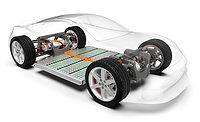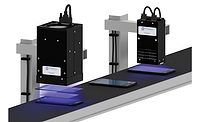UV Curing of Adhesives and Sealants in Green Manufacturing
UV LED curing offers multiple environmental and productivity benefits compared to traditional mercury bulbs.

One of the most popular solutions for utilizing adhesives, coatings, polymers, and resins in green manufacturing without resorting to solutions that require time or heat to cure/dry involves using ultraviolet (UV) radiation and a material that is capable of utilizing its energy to provide for a fast, on-demand cure. While mercury-based bulbs have long been a staple of the UV curing process, UV light-emitting diodes (LEDs) have made vast strides in becoming an excellent alternative due to their lower operating costs and superior lifetime over conventional bulbs.
As environmental awareness has gained traction and technology moved toward the “next big thing,” issues with mercury bulbs for industrial UV curing have started to become evident. In the manufacturing world, mercury creates a tremendous amount of heat that could, in some instances, damage the product being created. This is due to the large amount of energy required to operate the system, which also leads to high energy costs during operation.
Mercury is also a toxin and can leach into drinking water supplies underground when disposed of improperly. In addition, since the average bulb may only have a lifespan of several hundred to a few thousand hours before replacement, the number of bulbs being replaced leads to elevated amounts of this toxic waste, not to mention the cost, labor, and production line downtime required to change them.
By comparison, LEDs are small and versatile, and they offer longer life, higher efficiency, and smaller areas required to keep cool. With the proper design, UV LEDs can last tens of thousands of hours and require only a fraction of the energy and maintenance to do so. With the various benefits and looming hazardous materials regulations, many have begun to adopt the new technology.
While switching an industrial curing process from mercury to UV LED-based systems often results in a short capital expense payback period, as well as tax incentives in some instances due to their energy efficiency, several system considerations and material differences need to be considered. The switch is not as easy as changing a bulb. In fact, quite a bit of science is involved with the switch—involving how both the light and material behave—that few seem to understand or know how to achieve.
Multiple Variables
To begin, there unfortunately is often not a direct comparison or conversion of the various mercury bulbs to UV LEDs. A mercury bulb has a broadband spectral output that can span the wavelength spectrum from below 253.7 nm (the emission line of pure mercury when excited) to over 500 nm, depending on which bulb is selected. For instance, the difference between the commonly used mercury H and D bulbs is the wavelength peaks in the output spectrum. The H bulb has peaks below 320 nm and at 405 nm and 420 nm, while a D bulb has more concentrated wavelength peaks clustered together between 365-440 nm (see Figure 1).1
During formulation, a materials manufacturer will use various resins, polymers, pigments, and photoinitiators to create a material that produces a finished product that suits the application requirements while effectively using the spectral output of a readily available light source, like one of those bulbs, to provide the needed curing performance during manufacturing to allow the user of the resin or ink to effectively handle the material. Differing photoinitiators can often be used to tune the material to absorb different wavelengths of light to change the surface cure vs. depth-cure properties and rate of cure based on the output of the bulb chosen.
UV LEDs, on the other hand, have a narrow, monochromatic spectral output. Instead of a wide range of wavelengths, each with different peaks and intensities, UV LEDs produce a single wavelength peak of UV light and its surrounding wavelengths. Most UV LEDs are grouped into bins by their manufacturer to allow for a small tolerance in the actual peak wavelength, usually ± 5-10 nm. Outside this peak value, they also have a full-width, half-maximum rating (FWHM) that determines the breadth of the spectral output peak, measured from 50% intensity at each side of the peak. For instance, for the typical 365 nm LED output spectrum shown in Figure 2, its peak is roughly 366 nm and its FWHM is roughly 9 nm.
The differences between these two output spectra is not only why LEDs are more efficient than mercury, but also why different photoinitiators must often be used for materials that are formulated to be cured by specific technologies. Due to the preferential development of UV LEDs above the 365 nm range, in order for a material to be LED compatible it needs to have a photoinitiator that is compatible with the most common and powerful LED output spectra. For instance, typical UV LED outputs work well with photoinitiators such as TPO or BAPO. When examining BAPO’s absorption spectrum, along with a typical UV LED output, it becomes clear that UV LEDs are suited to output a wavelength of light that the photoinitiator can make effective use of.
However, if a material makes use of a photoinitiator that is more suited to the broad-spectrum curing of a mercury bulb, especially its output in the lower UVA range and down into UVB/C (e.g., the output of the H bulb below 350 nm), most LED curing systems will have trouble producing an output that correctly activates it. For instance, HCPK-type photoinitiators may find very little usable energy being emitted by most industrial UV LED curing systems, especially at low concentrations, and should be used with either specialty LED systems that do feature short-wavelength outputs or mercury-based bulbs. Notably, most of the energy that is emitted from mercury-based bulbs as visible light and heat does little toward UV curing; it simply decreases efficiency, increases operating costs, and in some cases can damage the product and substrate being cured.
This spectral output mismatch between the two technologies can also cause ratings and power outputs to become an apples-to-oranges comparison. While a mercury bulb may be rated at 400 W, be less than 10% efficient at converting electricity into radiation, and output 200 mW/cm² spread out all over the UVA range, for photoinitiators such as HCPK a large percentage of that output may still be above 350 nm—in the range that the photoinitiator cannot utilize. UV LEDs, on the other hand, may be rated at 400 W, have a 35% efficiency, and apply 200 mW/cm² over an even larger working area. In addition, when used with the appropriate material, UV LEDs can have almost all of their spectral output energy effectively used to excite the photoinitiator instead of wasting it in an unusable wavelength.
Unless you are formulating the resin, ink, or polymer yourself, you are often at the mercy of the UV-curable material manufacturer to design for these technological compatibilities. With the ever-increasing popularity and availability of UV LEDs in the curing world, photoinitiators that are compatible with UV LEDs are starting to be more commonplace; however, a lot of materials are still not as widely available. Even with materials that use a photoinitiator package that could be UV LED compatible, the proprietary nature of the blending or the lack of testing equipment or inclination can sometimes cause manufacturers to simply recommend a catch-all such as an H bulb, along with an artificially long, liability-free curing time on the material’s Technical Data Sheet.
This technological compatibility information can be hard to come by, even when contacting the manufacturer of the material directly. In addition, further testing methods are sometimes needed, either for material verification or particularly in cases of new product development. Options include purchasing various UV LED curing systems with different wavelengths and trying to cure the material or finding a UV LED curing equipment manufacturer that is willing to test the material.
A more scientific approach is to use an analytical instrument such as a differential scanning calorimeter (DSC), rheometer, Fourier-transform infrared (FTIR) spectrometer, or dynamic mechanical analyzer (DMA). Many analytical instrument manufacturers and other companies have developed UV LED-based photo-curing accessories to help take the guesswork out of characterizing materials. These analytical system accessories connect to an existing DSC and allow fast, repeatable, and in-house calorimetry testing while exposing the sample and reference materials to differing wavelengths of UV or visible light.
Such a system interfaces with the DSC to allow precise exposure triggering and can be calibrated in radiometric values to display the intensity received at the sample surface (usually in mW/cm²). This testing can be helpful to determine the phase changes and curing behavior of the material being tested. During testing, it could even be discovered that some materials may require more than one wavelength to help expedite the curing process. For example, shorter wavelengths (e.g., 365 nm) may provide for a fast, tack-free surface cure, but 405 nm may be necessary to allow for a higher depth-of-cure if the shorter wavelength is not potentially long enough to effectively pass through the material.
If the material in question is manufactured with a photoinitiator that is not compatible with UV LED curing, it will not cure with most commercially available UV LED curing systems, regardless of its energy output. However, due to the emerging availability of industry-suitable UVB/C LEDs, companies are starting to offer systems featuring multiple wavelengths—including those previously unavailable wavelengths that can provide the missing link between mercury bulb and UV LED outputs. For example, Figure 3 shows an example of a UV/VIS LED curing system’s spectrum with output wavelengths at 415 and 445 nm.
These multi-wavelength systems can enable industrial processes to be modernized without completely reworking the materials and handling processes. For some companies, changing the material is not a simple act. In some cases, such as applications that require government oversight or approval like military or medical/FDA, change is in fact a monumental task, one that some production facilities wish not to tackle unless absolutely necessary as it may require additional testing, potential stopping of production lines, training line workers, capital expense for new dispensing equipment, and so on. In those instances, a custom-designed UV LED system is an attractive option, as it provides all the benefits of switching over without the drawbacks of switching or reformulating materials.
Making Informed Decisions
The change from mercury bulb systems to UV LEDs in production line facilities is inevitable. Material manufacturers have recently been increasing their use of UV LED-friendly photoinitiators, but the availability of information is still lagging. The majority of end users just want their process to work and look to material and equipment manufacturers to steer them in the right direction, which may not always help.
Additional third-party assistance is sometimes required, whether with testing services, photo-accessories for existing testing equipment, curing equipment in specialty form factors or wavelengths, or recommendations for materials that are compatible with the desired curing technology. In order to not be left behind, companies will soon need to start retrofitting their processes to be compatible with new technologies. In the process, they will begin to discover the lower operating and maintenance costs, increased stability, and additional profitability of UV LED curing systems.
For additional information, visit www.digitallightlab.com.
Reference
- UV Lamp Spectra, UVDoctors, Inc., 2013, www.uvdoctors.com/uvlampspectra.html.

*percentage of SDM 100 companies, based on 95 responses
Source: 2020 SDM 100, SDM Magazine, May 2020

*percentage of SDM 100 companies, based on 86 responses
Source: 2020 SDM 100, SDM Magazine, May 2020

*average percentage of subscribers lost compared with beginning-of-year subscriber count
Source: 2020 SDM 100, SDM Magazine, May 2020

Number of vehicles used by SDM 100 companies*
Source: 2020 SDM 100, SDM Magazine, May 2020
Looking for a reprint of this article?
From high-res PDFs to custom plaques, order your copy today!











